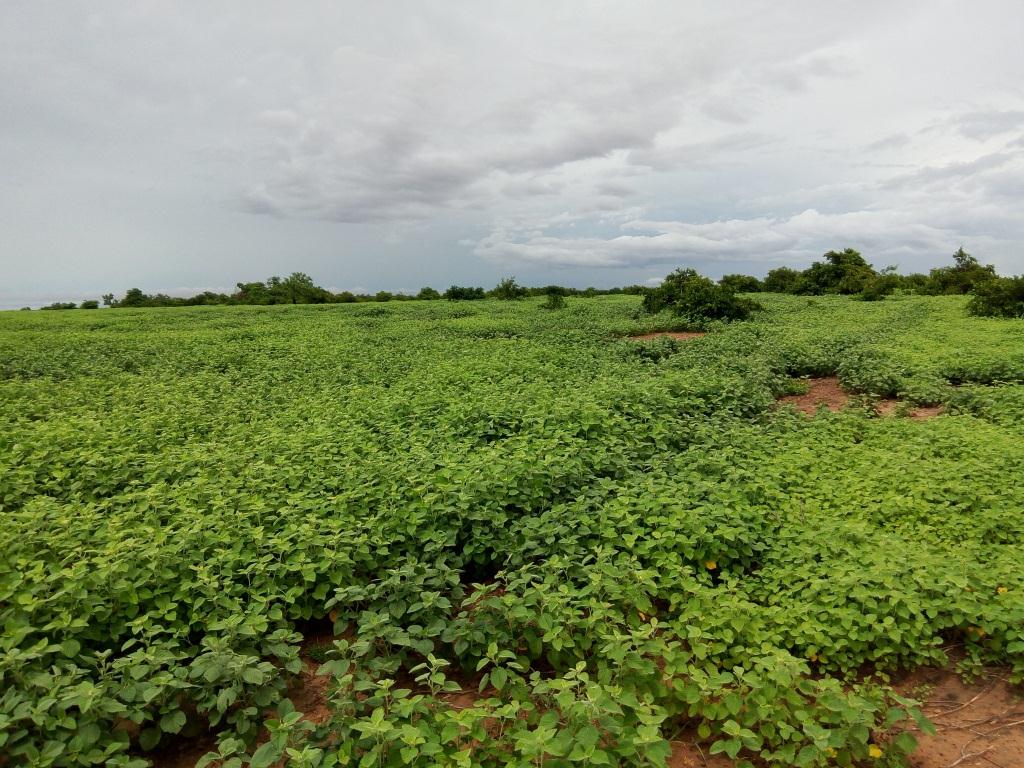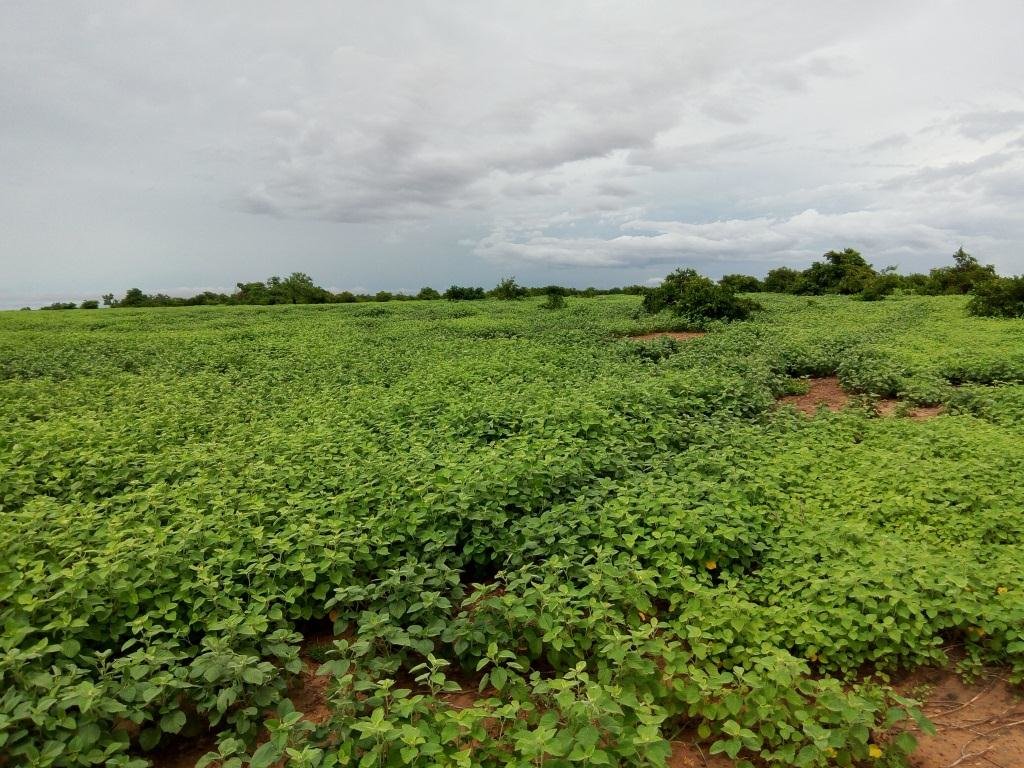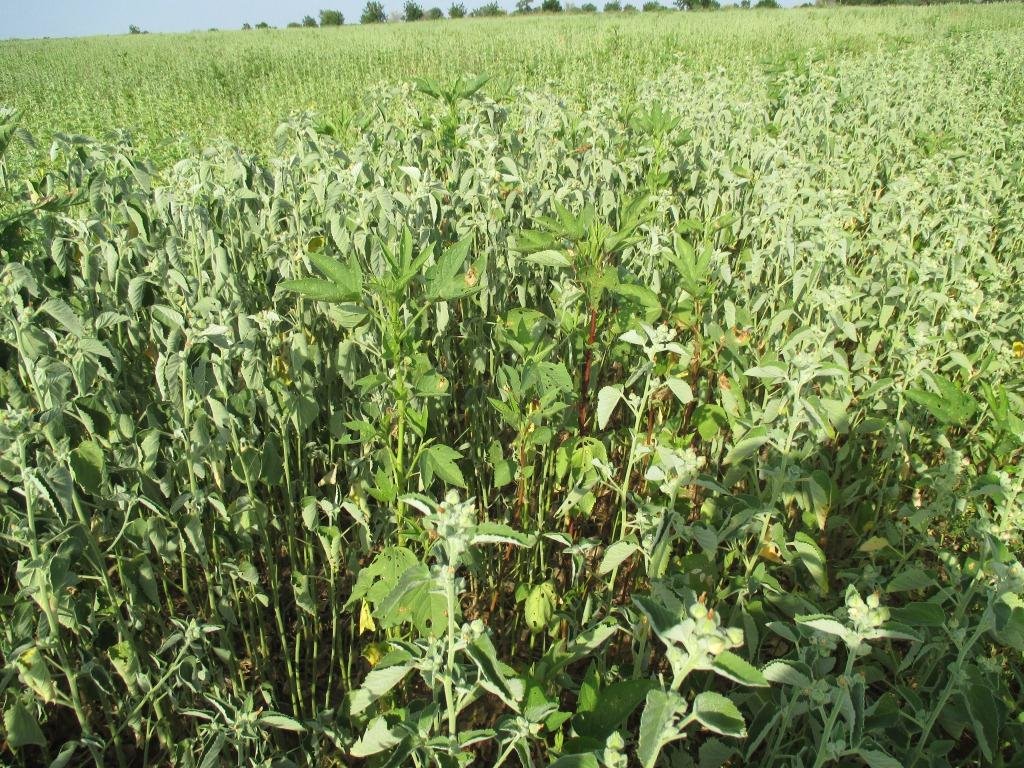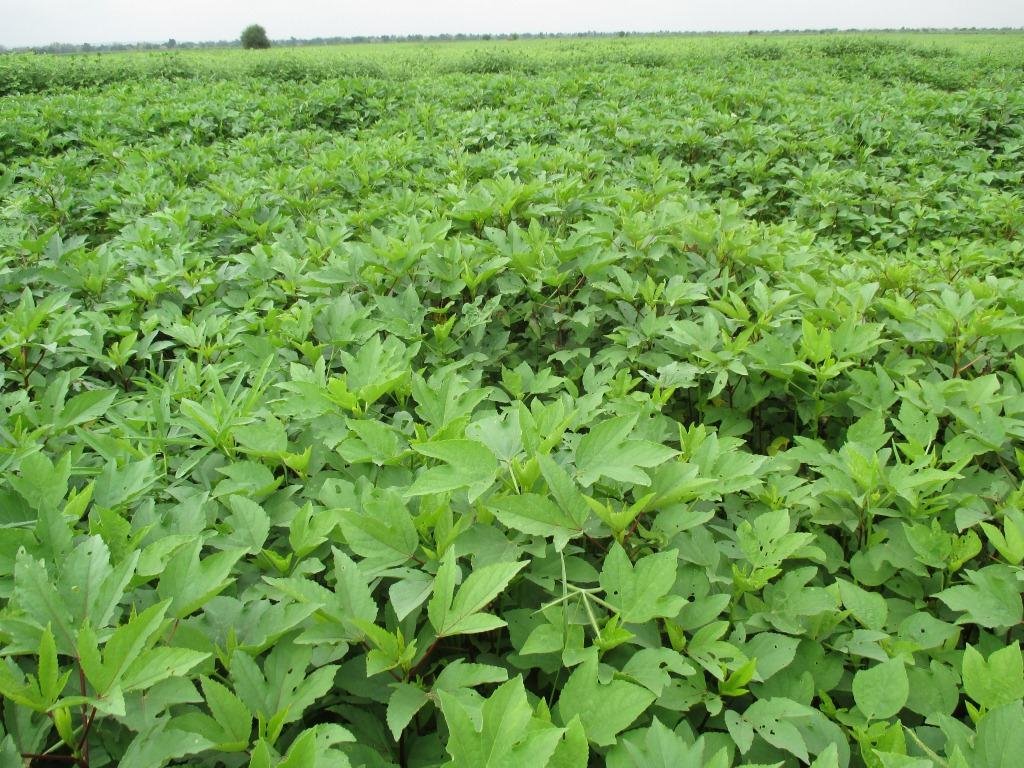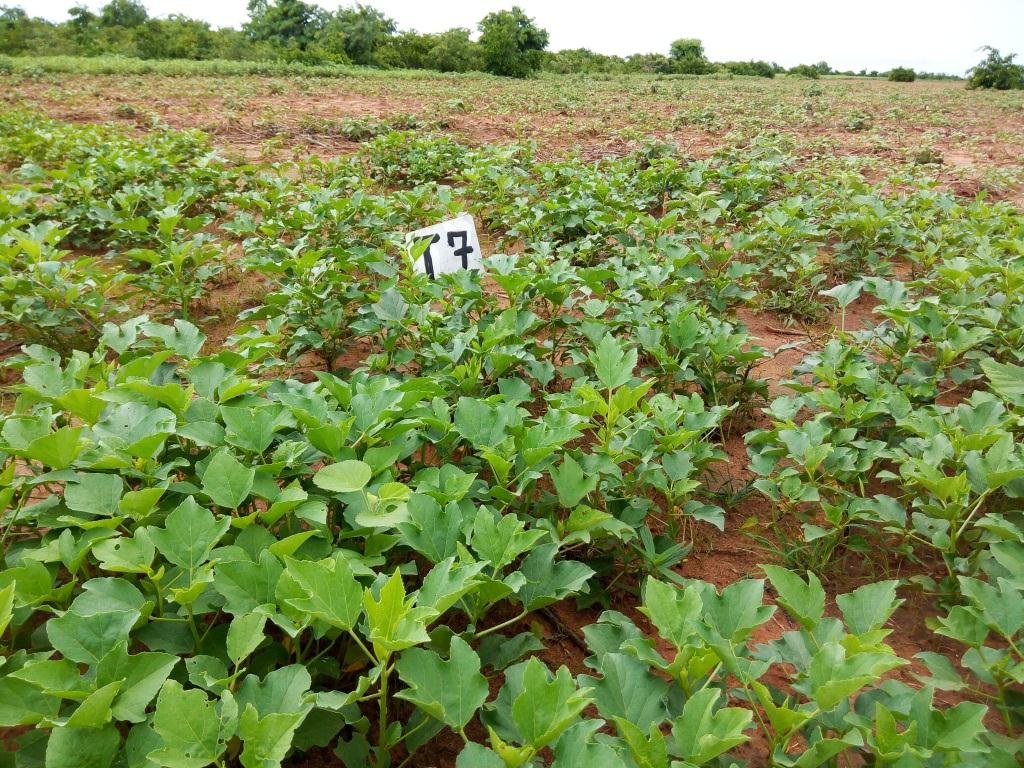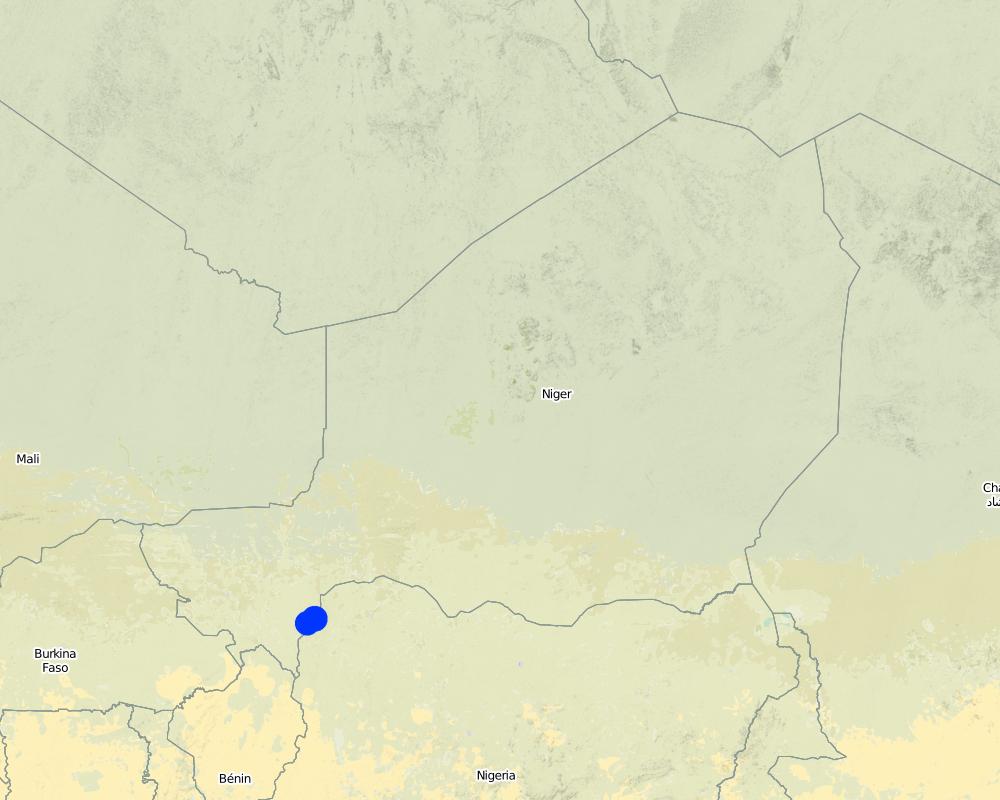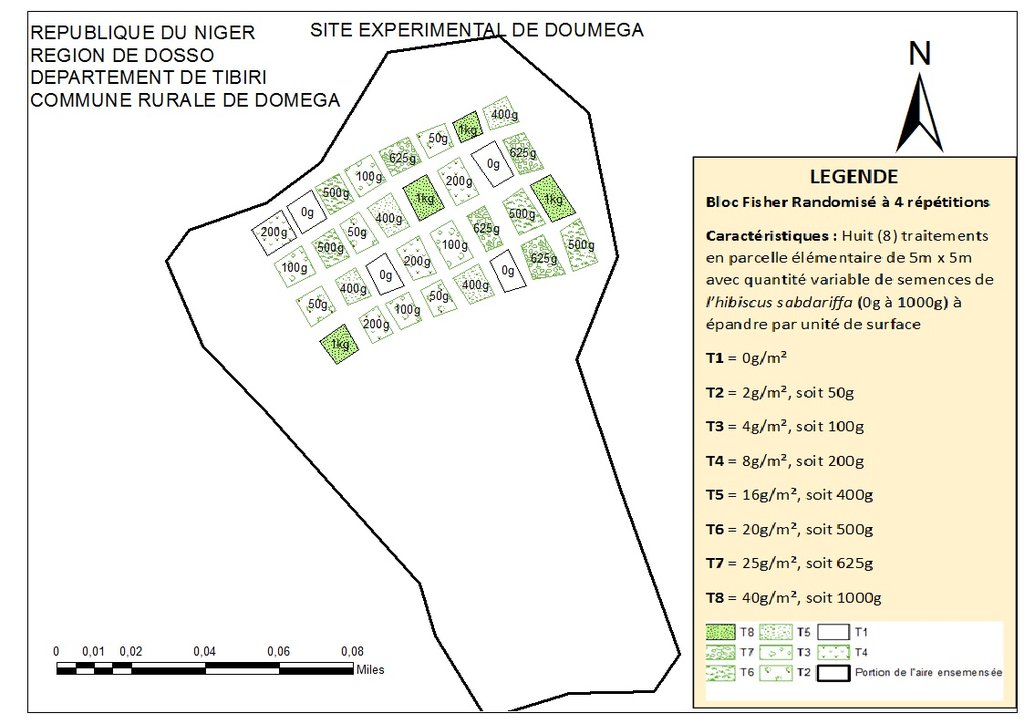Restoration of grazing land invaded by Sida cordifolia [Niger]
- Creation:
- Update:
- Compiler: Issaka DAN DANO
- Editor: Simone Verzandvoort
- Reviewers: Donia Mühlematter, Rima Mekdaschi Studer
Yaki da Garmani
technologies_3176 - Niger
- Full summary as PDF
- Full summary as PDF for print
- Full summary in the browser
- Full summary (unformatted)
- Restoration of grazing land invaded by Sida cordifolia : Jan. 30, 2018 (inactive)
- Restoration of grazing land invaded by Sida cordifolia : March 13, 2018 (inactive)
- Restoration of grazing land invaded by Sida cordifolia: June 6, 2019 (inactive)
- Restoration of grazing land invaded by Sida cordifolia: Nov. 2, 2021 (public)
View sections
Expand all Collapse all1. General information
1.2 Contact details of resource persons and institutions involved in the assessment and documentation of the Technology
land user:
Oumarou Chérif
+227 96980555 / +227 90571433
crdoumega@gmail.com
Rural municipality of Doumega
Municipality of Doumega, Region of Dosso, Department of Tibiri
Niger
land user:
Mounkara Adamou
+227 95959527 / +227 96273876
mailandarawakili@gmail.com
Rural municipality of Guéchémé
Rural municipality of Guéchémé, Region of Dosso, Department of Tibiri
Niger
SLM specialist:
Issaka Younoussa
+227 96436339 / +227 90133870
n/a
Communal Service for Livestock Keeping
Rural municipality of Géchémé, Region of Dosso
Niger
SLM specialist:
Issa Amadou
+227 96070621 / +227 92094170
n/a
Communal Service for Livestock Keeping of Doumega
Rural municipality of Doumega, Region of Dosso
Niger
Name of project which facilitated the documentation/ evaluation of the Technology (if relevant)
Programme d’Appui au Secteur de l’Elevage au Niger (PASEL 7)Name of the institution(s) which facilitated the documentation/ evaluation of the Technology (if relevant)
Vétérinaire Sans Frontière Belgique (VSF-Belgium) - Belgium1.3 Conditions regarding the use of data documented through WOCAT
When were the data compiled (in the field)?
20/09/2017
The compiler and key resource person(s) accept the conditions regarding the use of data documented through WOCAT:
Yes
1.4 Declaration on sustainability of the described Technology
Is the Technology described here problematic with regard to land degradation, so that it cannot be declared a sustainable land management technology?
No
Comments:
The technology enables to effectively combat invasive species such as Sida cordifolia, and to restore the grazing land.
2. Description of the SLM Technology
2.1 Short description of the Technology
Definition of the Technology:
Restoration of grazing land invaded by Sida cordifolia through the seeding of Hibiscus sabdariffa, for sustainable access to grazing areas and for reduced conflicts between farmers and livestock keepers.
2.2 Detailed description of the Technology
Description:
The agropastoral zone in the south of the region of Dosso experiences high pressure on land resources. The population is composed mostly of farmers and agro-pastoralists, practicing family-farming and extensive livestock keeping. The grazing areas are communal lands set aside for the animals in the rainy season, enabling the reduction of conflicts between farmers and livestock keepers. For more than two decades these areas have been invaded by Sida cordifolia, a species strongly disliked by the animals. An experiment is being conducted in two rural municipalities of the zone.
Several methods to combat Sida cordifolia have been attempted in the region: weeding, tillage, rotation, etc., but without great success. With the support of the “Program to Support the Livestock Keeping Sector in Niger”, PASEL, financed by the Swiss Cooperation in Niger, the municipalities of Guéchémé and Douméga have tested a method that combines two already known practices (tillage and weeding), and one novel practice, which consists of the seeding of the sites with Hibiscus sabdariffa, or roselle (“Oseille de Guinée”), a plant that is normally used to make tea or eaten as a vegetable. But it is also valuable as a fodder.
In the year following the seeding of Hibiscus sabdariffa, the plants grow with the first rains. Because of its rapid germination, the hibiscus invades the area very quickly, and suffocates the first seedlings of the Sida cordifolia. Using this method, which combines several techniques, the sites have been restored . But they remain vulnerable, because the Sida cordifolia has invaded all the non-cultivated areas in the region, and can very quickly recapture the restored areas. Only more far-reaching and sustained action can put an end to the colonization of the grazing areas. This technology enables the reduction of conflicts between livestock keepers and farmers, while keeping the animals in the region, but at the same time restricting their straying into crop lands. The nutritious character of the fodder that is produced by hibiscus contributes to improved fattening of the animals, and better milk production for the families of neighbouring pastoralists.
From an environmental point of view, the return of certain grasses and herbs has been noted. Eragrotis tremula, Commelina froskalei, and Brachiara ramosa had disappeared. Nevertheless, the livestock keepers fear that the restored zones will be recaptured by Sida cordifolia because the treatment was only carried out on part of the area. However they appreciate the fact that they can keep a part of the herd in place, that land tenure has been secured - and that the municipality has shown interest in the livestock keeping.
2.3 Photos of the Technology
General remarks regarding photos:
The images correspond to the plots on the map of the site.
2.5 Country/ region/ locations where the Technology has been applied and which are covered by this assessment
Country:
Niger
Region/ State/ Province:
Region of Dosso
Further specification of location:
Municipality of Doumega, Area of Angoual Doutsi and Area of Yangana
Map
×2.6 Date of implementation
Indicate year of implementation:
2016
2.7 Introduction of the Technology
Specify how the Technology was introduced:
- through projects/ external interventions
Comments (type of project, etc.):
The idea arose from the exchanges between the Mayors and the regional coordination of the 'Initiative Nigerians feed Nigerians (i3N)', a program of the Nigerian government.
3. Classification of the SLM Technology
3.1 Main purpose(s) of the Technology
- improve production
- reduce, prevent, restore land degradation
- conserve ecosystem
- create beneficial economic impact
- create beneficial social impact
3.2 Current land use type(s) where the Technology is applied
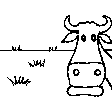
Grazing land
Extensive grazing land:
- Semi-nomadism/ pastoralism
Main animal species and products:
Feed production for the cattle and small ruminants (sheep, goats).
Comments:
n/a
If land use has changed due to the implementation of the Technology, indicate land use before implementation of the Technology:
No change in the use of grazing areas.
3.3 Further information about land use
Water supply for the land on which the Technology is applied:
- rainfed
Comments:
The technology is applied to grazing areas close to the villages, where the animals are fenced during the rainy season, with tracks giving access to water sources.
Number of growing seasons per year:
- 1
Specify:
The activity is only carried out during the rainy season.
Livestock density (if relevant):
n/a
3.4 SLM group to which the Technology belongs
- pastoralism and grazing land management
3.5 Spread of the Technology
Specify the spread of the Technology:
- evenly spread over an area
If the Technology is evenly spread over an area, indicate approximate area covered:
- 0.1-1 km2
Comments:
The grazing area is bounded, and is registered in the rural records (50 ha per treated zone).
3.6 SLM measures comprising the Technology

vegetative measures
- V4: Replacement or removal of alien/ invasive species
Comments:
Control and replacement of Sida cordifolia by Hibiscus sabdariffa.
3.7 Main types of land degradation addressed by the Technology

biological degradation
- Bc: reduction of vegetation cover
- Bq: quantity/ biomass decline
Comments:
In general, Sida cordifolia has been spread by the animals into all grazing areas.
3.8 Prevention, reduction, or restoration of land degradation
Specify the goal of the Technology with regard to land degradation:
- reduce land degradation
- restore/ rehabilitate severely degraded land
Comments:
n/a
4. Technical specifications, implementation activities, inputs, and costs
4.1 Technical drawing of the Technology
4.2 Technical specifications/ explanations of technical drawing
Design: randomised Fisher blocks in 4 repetitions.
Unit plots of 5m x 5m
Five (5) treatments (varying in the quantity of roselle - Hibiscus sabdariffa - seed to spread per unit area).
Results:
Observations following the differentiation in seeding Hibiscus sabdariffa on an area with a density of approximately 120 plants of Sida cordifolia per m2:
- T2 to T4: the plants of the two species grow thinly together without impeding each other. The density is not sufficient to cover the entire plot and to prevent the development of Sida cordifolia.
- T5 to T7: not very satisfactory results, but with a clear difference between the plants of Hibiscus sabdariffa and those of Sida cordifolia. Between 10 and 20% of the plots are not sufficiently covered, which explains the presence of several remaining plants of Sida cordifolia.
- T8: full cover (200 plants of Hibiscus sabdariffa per m2 on average). Several plants of Sida cordifolia are still able to grow, but cannot develop and will produce only a small amount of seeds, or none at all in the majority of cases.
These results vary with the soil type: if the soil is fertile, even from treatment T7 onwards the results are very satisfactory, because the leaves grow quickly and provide shade, which is a prerequisite for preventing the development of Sida cordifolia.
4.3 General information regarding the calculation of inputs and costs
Specify how costs and inputs were calculated:
- per Technology area
Indicate size and area unit:
50 hectares
If using a local area unit, indicate conversion factor to one hectare:
n/a
other/ national currency (specify):
FCFA
Indicate average wage cost of hired labour per day:
2000 FCFA
4.4 Establishment activities
| Activity | Type of measure | Timing | |
|---|---|---|---|
| 1. | Site selection | Management | April to May |
| 2. | Social agreement | Management | April to May |
| 3. | Securing land tenure | Management | preliminary to any action |
| 4. | Establishment of management committee | Management | May |
| 5. | Preparation of the terrain | Vegetative | May |
| 6. | Purchase of seeds | Vegetative | April |
| 7. | Sowing | Vegetative | at the first or second rains in June |
| 8. | Technical monitoring and closure of the areas for grazing | Vegetative | June to October |
| 9. | Maintenance of the plots | Vegetative | June to August |
| 10. | Assessment of the biomass | Vegetative | October |
| 11. | Releasing the area to livestock keepers | Management | October |
Comments:
The approach implemented in two sites of 50 ha each consists of:
1. Site selection: geo-referencing and verification of the ownership status of the land;
2. Negotiation and establishment of a social agreement between the main users. This process consists of awareness-raising of the local farmers and livestock keepers, agreement on the rules for management and the terms of access, signing of the agreement by the village head and the leader of the livestock keepers (rougga);
3. Securing the land tenure by issuing a land act by the land commission, and registration in the rural records of the municipality;
4. Establishment of the management committee and training of its members in management, organisation and conducting the restoration works in the areas;
5. Preparation of the terrain: improved clearance (to eliminate seeds), tillage by mechanised harrowing using a tractor or ox plow after the first seedlings of Sida cordifolia emerge (first or second rains);
6. Purchase of seeds of Hibiscus sabdariffa on the local markets;
7. Dry sowing or sowing after a rainfall event: in pockets or by broadcasting. The experiments showed that the sowing by broadcasting with a density of 25 to 40 g per m2 was more effective (cf. the technical drawing, plots T7 and T8);
8. Periodic monitoring and partial closure of the areas for grazing: regular field visits by the technical service and by the municipality, surveillance carried out by the communities and paid by the municipality;
9. Maintenance of the plots: weeding by pulling out the emerging plants of Sida cordifolia, prohibition to collect seed;
10. Assessment of the biomass: estimation of the gross production by the communal service for livestock keeping in Doumega (15.5 tonnes of dry matter per ha);
11. After maturity, release of the area to livestock keepers.
The calendar of these practices may vary according to the arrival of the rainy season.
4.5 Costs and inputs needed for establishment
| Specify input | Unit | Quantity | Costs per Unit | Total costs per input | % of costs borne by land users | |
|---|---|---|---|---|---|---|
| Labour | Awareness-raising | meeting | 1.0 | 95600.0 | 95600.0 | |
| Labour | Labour | harrowing | 1.0 | 14077770.0 | 14077770.0 | |
| Labour | Purchase and sowing of Hibiscus | 1.0 | 3450000.0 | 3450000.0 | ||
| Labour | Training | 1.0 | 347030.0 | 347030.0 | ||
| Other | Technical supervision | 1.0 | 367.0 | 367.0 | ||
| Other | Monitoring | 1.0 | 332.0 | 332.0 | ||
| Total costs for establishment of the Technology | 17971099.0 | |||||
If land user bore less than 100% of costs, indicate who covered the remaining costs:
The program to support the livestock keeping sector - PASEL7 - has ensured the financing.
Comments:
The municipalities have contributed to the financing, but the amounts have not been appraised.
4.6 Maintenance/ recurrent activities
| Activity | Type of measure | Timing/ frequency | |
|---|---|---|---|
| 1. | Surveillance | Vegetative | June to October |
4.7 Costs and inputs needed for maintenance/ recurrent activities (per year)
If land user bore less than 100% of costs, indicate who covered the remaining costs:
Program to Support the Livestock Keeping Sector in Niger PASEL7
Comments:
Seed is no longer purchased, because the seeds of the previous year develop with the rainfall.
4.8 Most important factors affecting the costs
Describe the most determinate factors affecting the costs:
The purchase and broadcasting of the seeds.
5. Natural and human environment
5.1 Climate
Annual rainfall
- < 250 mm
- 251-500 mm
- 501-750 mm
- 751-1,000 mm
- 1,001-1,500 mm
- 1,501-2,000 mm
- 2,001-3,000 mm
- 3,001-4,000 mm
- > 4,000 mm
Specifications/ comments on rainfall:
The average duration of the rainfall is 30 days for each rainy season.
Agro-climatic zone
- semi-arid
5.2 Topography
Slopes on average:
- flat (0-2%)
- gentle (3-5%)
- moderate (6-10%)
- rolling (11-15%)
- hilly (16-30%)
- steep (31-60%)
- very steep (>60%)
Landforms:
- plateau/plains
- ridges
- mountain slopes
- hill slopes
- footslopes
- valley floors
Altitudinal zone:
- 0-100 m a.s.l.
- 101-500 m a.s.l.
- 501-1,000 m a.s.l.
- 1,001-1,500 m a.s.l.
- 1,501-2,000 m a.s.l.
- 2,001-2,500 m a.s.l.
- 2,501-3,000 m a.s.l.
- 3,001-4,000 m a.s.l.
- > 4,000 m a.s.l.
Indicate if the Technology is specifically applied in:
- not relevant
Comments and further specifications on topography:
No data to further specify the topography, but the area consists of plateaus and plains.
5.3 Soils
Soil depth on average:
- very shallow (0-20 cm)
- shallow (21-50 cm)
- moderately deep (51-80 cm)
- deep (81-120 cm)
- very deep (> 120 cm)
Soil texture (topsoil):
- coarse/ light (sandy)
Topsoil organic matter:
- low (<1%)
If available, attach full soil description or specify the available information, e.g. soil type, soil PH/ acidity, Cation Exchange Capacity, nitrogen, salinity etc.
n/a
5.4 Water availability and quality
Ground water table:
5-50 m
Availability of surface water:
poor/ none
Water quality (untreated):
good drinking water
Is water salinity a problem?
No
Is flooding of the area occurring?
No
Comments and further specifications on water quality and quantity:
n/a
5.5 Biodiversity
Species diversity:
- medium
Habitat diversity:
- low
Comments and further specifications on biodiversity:
n/a
5.6 Characteristics of land users applying the Technology
Sedentary or nomadic:
- Sedentary
- Semi-nomadic
Market orientation of production system:
- subsistence (self-supply)
Off-farm income:
- less than 10% of all income
Relative level of wealth:
- poor
Individuals or groups:
- individual/ household
- groups/ community
Level of mechanization:
- manual work
- animal traction
Gender:
- women
- men
Age of land users:
- youth
- middle-aged
Indicate other relevant characteristics of the land users:
n/a
5.7 Average area of land owned or leased by land users applying the Technology
- < 0.5 ha
- 0.5-1 ha
- 1-2 ha
- 2-5 ha
- 5-15 ha
- 15-50 ha
- 50-100 ha
- 100-500 ha
- 500-1,000 ha
- 1,000-10,000 ha
- > 10,000 ha
Is this considered small-, medium- or large-scale (referring to local context)?
- medium-scale
Comments:
The high population pressure has caused the fragmentation of family holdings, which are not large enough to meet the needs of the households.
5.8 Land ownership, land use rights, and water use rights
Land ownership:
- communal/ village
- individual, not titled
Land use rights:
- communal (organized)
- individual
Water use rights:
- communal (organized)
- individual
Comments:
In Niger, the ownership of rural land is regulated by the rural code through the land commissions.
5.9 Access to services and infrastructure
health:
- poor
- moderate
- good
education:
- poor
- moderate
- good
technical assistance:
- poor
- moderate
- good
employment (e.g. off-farm):
- poor
- moderate
- good
markets:
- poor
- moderate
- good
energy:
- poor
- moderate
- good
roads and transport:
- poor
- moderate
- good
drinking water and sanitation:
- poor
- moderate
- good
financial services:
- poor
- moderate
- good
6. Impacts and concluding statements
6.1 On-site impacts the Technology has shown
Socio-economic impacts
Production
fodder production
Quantity before SLM:
almost nil
Quantity after SLM:
775 tons of dry matter
Comments/ specify:
The sites were almost invaded, but with the restoration, the grassland has recovered. The amount of biomass has not been estimated before the restoration.
fodder quality
Quantity before SLM:
n/a
Quantity after SLM:
n/a
Comments/ specify:
The quality of the fodder has improved.
animal production
Quantity before SLM:
n/a
Quantity after SLM:
n/a
Comments/ specify:
Fattening of animals has improved due to the nutritional quality of the hibiscus.
Socio-cultural impacts
land use/ water rights
Quantity before SLM:
n/a
Quantity after SLM:
n/a
Comments/ specify:
The sites have been secured, and their status has been clarified to and acknowledged by all the users.
community institutions
Quantity before SLM:
n/a
Quantity after SLM:
n/a
Comments/ specify:
The establishment of the management committee has strengthened the local institutional context.
SLM/ land degradation knowledge
Quantity before SLM:
n/a
Quantity after SLM:
n/a
Comments/ specify:
The population have learnt more about sustainable land management through the measures implemented.
conflict mitigation
Quantity before SLM:
n/a
Quantity after SLM:
n/a
Comments/ specify:
There are fewer conflicts between farmers and livestock keepers, because the areas have become suitable for the livestock.
situation of socially and economically disadvantaged groups
Quantity before SLM:
n/a
Quantity after SLM:
n/a
Comments/ specify:
The position of the livestock keepers has improved through the recognition of the specific character of their production system by the municipality.
Ecological impacts
Biodiversity: vegetation, animals
Vegetation cover
Quantity before SLM:
n/a
Quantity after SLM:
n/a
Comments/ specify:
The vegetation cover has been restored with species that are useful for the livestock keepers.
biomass/ above ground C
Quantity before SLM:
n/a
Quantity after SLM:
n/a
Comments/ specify:
n/a
plant diversity
Quantity before SLM:
n/a
Quantity after SLM:
n/a
Comments/ specify:
Certain vegetation species have returned which had been formerly suppressed by the development of Sida cordifolia.
invasive alien species
Quantity before SLM:
n/a
Quantity after SLM:
n/a
Comments/ specify:
The hibiscus has managed to impede Sida cordifolia better than any other species. If the required density is preserved, the latter is completely suppressed.
6.2 Off-site impacts the Technology has shown
Comments regarding impact assessment:
No collateral damage was observed.
6.3 Exposure and sensitivity of the Technology to gradual climate change and climate-related extremes/ disasters (as perceived by land users)
Gradual climate change
Gradual climate change
| Season | Type of climatic change/ extreme | How does the Technology cope with it? | |
|---|---|---|---|
| seasonal rainfall | wet/ rainy season | decrease | well |
Comments:
The zone, like all arid zones, is subject to the effects of climate change. Still, the consequences have not yet been disastrous, apart from the inter-annual variability of rainfall. The experiment has shown that Hibiscus is a plant which is more resistant to water stress than Sida cordifolia.
6.4 Cost-benefit analysis
How do the benefits compare with the establishment costs (from land users’ perspective)?
Short-term returns:
slightly positive
Long-term returns:
positive
How do the benefits compare with the maintenance/ recurrent costs (from land users' perspective)?
Short-term returns:
positive
Long-term returns:
very positive
Comments:
The long-term returns are positive in the sense that there are almost no recurring costs.
6.5 Adoption of the Technology
- single cases/ experimental
If available, quantify (no. of households and/ or area covered):
n/a
Comments:
The technology is part of a community-based approach, and does not concern individuals or households.
6.6 Adaptation
Has the Technology been modified recently to adapt to changing conditions?
No
6.7 Strengths/ advantages/ opportunities of the Technology
| Strengths/ advantages/ opportunities in the land user’s view |
|---|
| The technology has enabled the restoration of areas at risk of loosing their original function as grazing. |
| Participatory and inclusive approach (livestock keepers, farmers, men, women, young persons) |
| The technology is fully manageable for the local population. |
| Strengths/ advantages/ opportunities in the compiler’s or other key resource person’s view |
|---|
| Strong engagement of the communities in the implementation |
| The securing of grazing areas threatened by degradation, and by the loss of their status as communal lands. |
6.8 Weaknesses/ disadvantages/ risks of the Technology and ways of overcoming them
| Weaknesses/ disadvantages/ risks in the land user’s view | How can they be overcome? |
|---|---|
| Violation of the rules for the protection of grazing areas by some livestock keepers, who found the period too long. | Strengthen the information system, and provide more interactions between the management committee and the livestock keepers. |
| A mechanism for the rotation of the restoration works in the area has not been established; only a part of 50 ha has been managed. | Plan for the remaining area, which was not restored, for the next years of PASEL7. |
| Weaknesses/ disadvantages/ risks in the compiler’s or other key resource person’s view | How can they be overcome? |
|---|---|
| The experiment was carried out on a small area compared to the extent of the problem, which covers the entire southern strip of the country. | Continue research with the Institute of Agronomic Research in Niger, in order to capitalize on, and develop, a large-scale project to combat this scourge effectively. |
7. References and links
7.1 Methods/ sources of information
- field visits, field surveys
The visits were used for observation and for geo-referencing on the site.
- interviews with SLM specialists/ experts
Small workshop with a dozen of persons.
7.2 References to available publications
Title, author, year, ISBN:
Guide Méthodologique: Processus d'élaboration du schéma d’aménagement foncier (SAF), avril 2011
Available from where? Costs?
Ministry of Agriculture and Livestock Keeping, Permanent secretary of the rural code in Niger
Title, author, year, ISBN:
Conflits fonciers ruraux au Niger: les mécanismes de prévention et de gestion, édition 2014,
Available from where? Costs?
Ministry of Agriculture and Livestock Keeping, Permanent secretary of the rural code in Niger
Title, author, year, ISBN:
Sécurisation des Espaces Pastoraux, Programme d'Appui au secteur de l’élevage phase 6 (PASEL6), 2015
Available from where? Costs?
VSF-Belgium in Niger
7.3 Links to relevant information which is available online
Title/ description:
n/a
URL:
n/a
Links and modules
Expand all Collapse allLinks
No links
Modules
No modules


